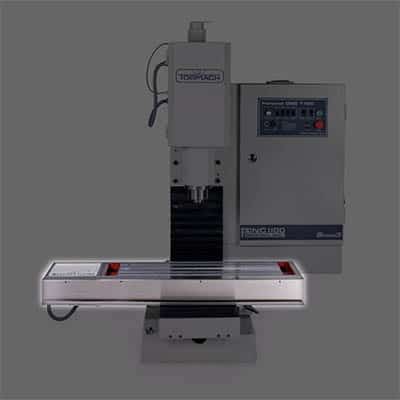Select a Part:
Frame
Table
Spindle
Axes
CNC Controller
Accessories

This Guide to DIY CNC Milling Machine Parts is designed for exploration and learning. This page is the home page and visual table of contents. Click the menu above to scroll to a particular part of a typical CNC Milling Machine. You’ll get a brief overview of the part together with links that let you drill down and discover more detail about the CNC Mill Part.
Use the Guide as an aid to help you make good design choices for your own DIY CNC Milling Machine project. If you're more interested in CNC Routers, try our Guide to DIY CNC Router Parts.
If this is way too deep for you, drop back and check out our "What is CNC?" article.

Frame
The frame supports the machine and provides rigidity to resist cutting forces. Typically, there is a base with a detachable column.
CNC Milling Machine Frames are most commonly made of cast iron. Other possibilities include weldments with epoxy granite fill and aluminum.

Table
The table is where a workholding solution of some kind holds the workpiece for machining. Most milling machine tables use T-Slots to attach workholding to the table. You can make a T-Slot table even more useful and versatile by mounting a Fixture Plate on it.

Spindle
The spindle is the heart of any milling machine. It consists of a rotating assembly with a taper where tool holders may be installed.
A motor with optional transmission of some kind rotates the spindle.

Axes
The axes of a CNC Milling Machine allow motion using Cartesian coordinates programmed via g-code and via manual jogging from the control panel.
Generally, there are 3 axes that correspond to X, Y, and Z. An optional 4th Axis is an accessory for CNC Milling Machines. There are even 4Axis CNC Routers. 5 axis milling machines are possible but not very common in the DIY CNC world.
The Axes consist of 2 components. First, there is the suspension system that allows the axis to move and keeps it aligned so it moves in a straight line in the proper orientation to other axes. Second is the system that converts the motion of the drive motor to the linear motion of the axis travel. For exampe, a rack and pinion drive or ball screws for cnc drive.

CNC Controller
The CNC Controller is the brains of the machine. It contains the electronics that drive the axis motors to move the axes.
CNC Controllers are responsible for accepting G-Code and manual inputs from the CNC Control Panel and converting that into the proper signals to control the Axis Stepper or Servo Motors.
CNC Milling Machine Accessories

Coolant
CNC Coolant plays multiple roles in cutting and it comes in many forms. There are several types of coolant system common in DIY CNC including: - Mist Coolant - Flood Coolant - Air Blast or Cool Air Gun - Dust Collector While a Dust Collector doesn't "cool", it satisfies the primary rool of Coolant which is chip evacuation.
Way Oiler
CNC Milling Machines need lubrication for their leadscrews and especially their ways. Ways are whatever mechanism is used to allow the axes to slide.
Way Oilers can be manual or automatic. An automatic electric way oiler adds considerably to reliability by ensuring consistent friction and less wear on the ways.

Powered Drawbar
Powered or Power Drawbars are a tremendous convenience for CNC Milling Machines and an absolute requirement if an Automatic Tool Changer is to be used. Basically, they allow push button capture and release of tool holders from the spindle. There are three prevalent types including Impact Wrench, Tormach TTS Style, and Pull Stud. Machines without a Power Drawbar require the operator to loosen the drawbar (or a collet depending on the spindle) with wrenches, which takes much longer than the push button style.

Enclosure
CNC Milling Machines are inherently messy beasts. They will throw chips long distances. If they're equipped with flood coolant, the mess is even worse. With an Enclosure, the mess is kept inside and doesn't get all over your workshop.

4th Axis
A 4th Axis installs on the CNC Milling Machine's and adds another axis of motion. They're useful for a variety of things ranging from allowing more sides of parts to be machined in one setting to allowing more parts to be held on the table to allowing continuous rotary machining or engraving.
Be the first to know about updates at CNC Cookbook
Join our newsletter to get updates on what's next at CNC Cookbook.
